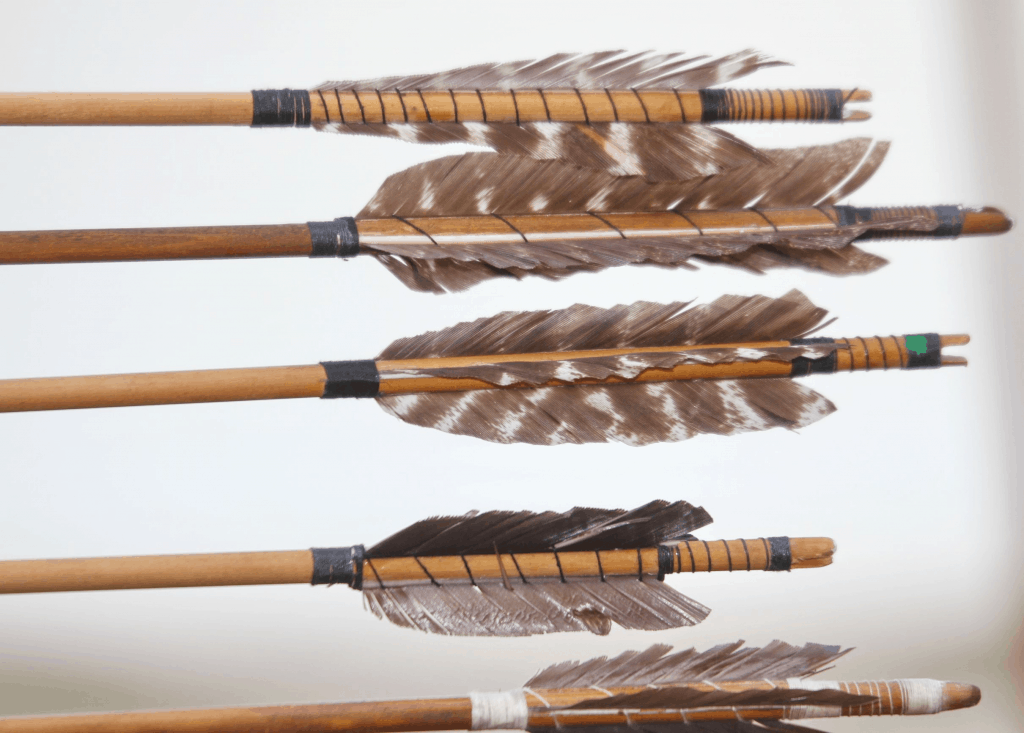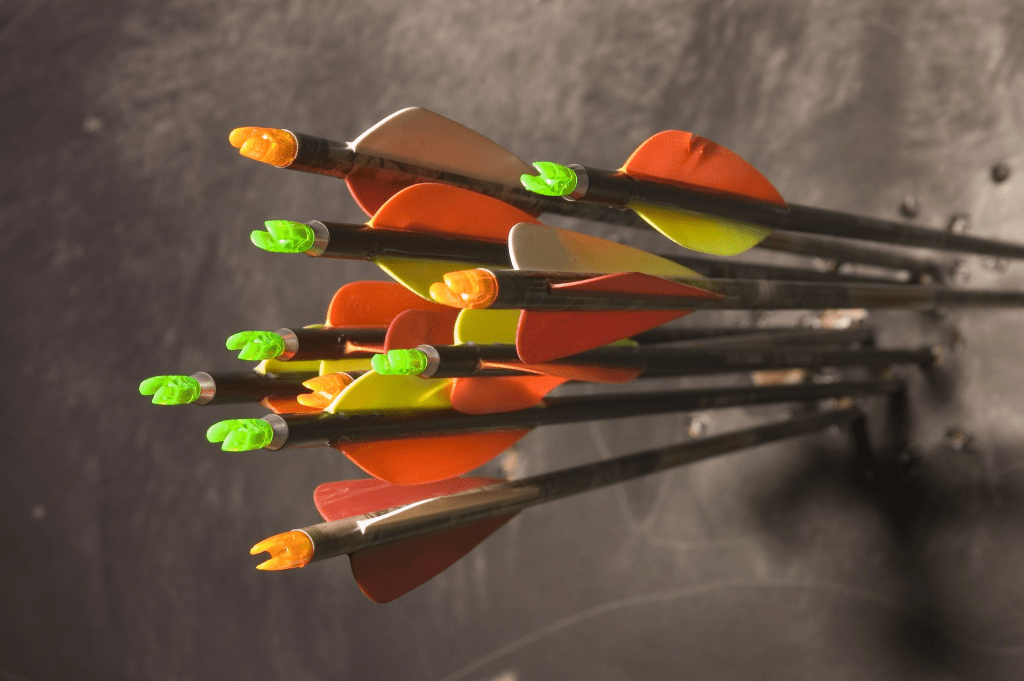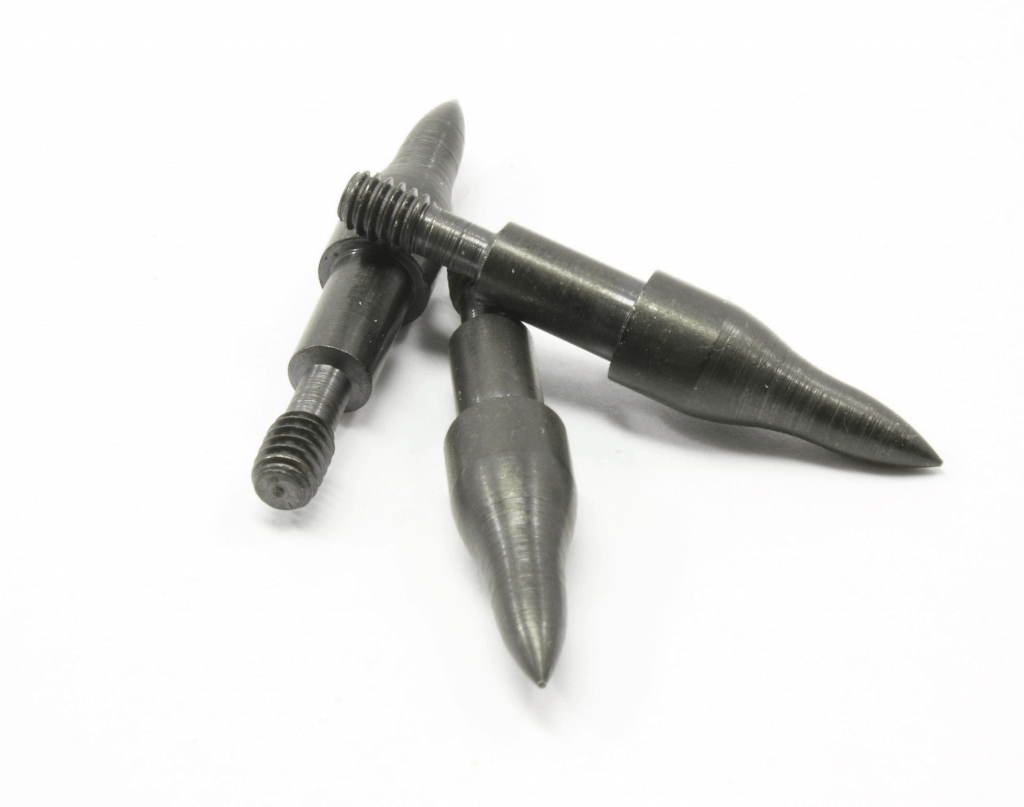
As a sport, archery includes some of the most customizable equipment on the market. Bowhunters and target shooters can manipulate nearly every detail of their gear to serve their particular needs. The feathers or plastic strips at the end of an arrow, called fletchings, are one such element that can be shaped, cut, and attached in many different ways.
The size of fletching you use depends on multiple factors. The diameter of your arrow, it’s material, the environment you’re shooting in, the kind of arrowhead you’re using, the distance you need it to go, and whether you’re using it to shoot targets or animals will all affect the recommended fletching size.
To learn everything you’ll need to know about choosing the right size fletching for your arrow, continue reading this article.
Fletching Sizes Reviewed
What Is a Fletching?
In case you’re new to archery and have somehow stumbled onto an article about fletching sizes without fully understanding what fletchings are, let’s review.
Fletching is both a general noun for the feather or imitation feather at the nock end of an arrow and a verb for the process of attaching that feather to the arrow.
There are usually three to four fletchings on an average arrow.
Essentially, they help the arrow fly in a straight (or straighter than they would fly without the fletching) path toward their target.
It’s never a good idea to shoot an arrow without any fletchings unless it is for calibration purposes.
The fletchings help the back end of the arrow follow the front end, which is pretty important if you want to make accurate shots.
The size of the fletching will affect the arrow’s flight path, and seasoned archers will know which fletching sizes are best for certain shooting scenarios.
What the Sizes Mean
Choosing the correct fletching for your arrow involves more than just a question of size, but let’s start with size to establish a general baseline of types of fletchings.
The range of fletching sizes averages from about two inches to five or six inches, with a few outliers.
Equally essential as the length of the fletching, if not more essential, is the profile or surface area of the fletching.
The profile of the fletching consists of the distance between the shaft of the arrow and the widest point of the fletching.
There are many combinations of length and profile that can be made to customize the fletchings, and each will have their own respective effect on the flight path.
Longer fletchings with high profiles are going to create the most drag on an arrow, slowing it down. However, they also offer the best assistance to the arrow, correcting its path and keeping it straight as it flies.
Shorter, less high-profile fletchings will create the least amount of drag, causing it to have the least amount of hindrance on your arrow’s speed but offering less assistance if you’ve released the arrow with bad form, causing it to fly crooked.
But, as I mentioned before, you’re not limited to these two options.
Combining a short length with a high profile leaves you with a fletching that won’t create as much drag on your arrow but also quickly corrects any abnormalities in your arrow’s flight path as it travels.
World Champion David Houser is not alone in preferring this particular fletching size for his bowhunting exploits, as it ensures that his arrow will have the speed to travel long distances but the accuracy to still hit his target when the distance is run.
In general, the more surface area your fletching has, the more it is going to slow down your arrow while helping it maintain a straight path, making it typically better for short distances. The smaller it is, the less drag you get without the benefit of correction after your arrow has left the string, making it the slightly better choice for long distances.
How Materials Impact Fletching Size
Don’t go running off to the outdoor store to buy your new fletchings yet. There are still a lot of factors to consider when choosing your fletchings.
The types of materials used here will enable us to specify our vocabulary.
Feathers

Advantages
Fans of traditional archery equipment will recognize feathers as the most common source for fletchings. If you’re using feathers on your arrows, they don’t get a fancy name. They’re just called feathers.
In most cases, the feathers you’ll see on an arrow have been fashioned from the primary flight feathers of a turkey.
There are a few pros and cons to using a few feathers as your arrow’s fletching apart from looking more like Robin Hood, which you may see as either a pro or a con depending on your background.
The advantage of using feathers is that they are lighter and more flexible. The lighter weight enables your arrow to stay in the air longer and therefore travel longer distances, which is why many bowhunters prefer using them.
Their flexibility is a positive factor for those who want to minimize the amount of drag created by contact between the fletching and the riser or the rest as the archer releases the string.
Disadvantages
The downfall of the traditional feather fletching comes with bad weather. Unprotected from the rain or other wet conditions, feathers can become flat, weighed down by the weight of the water, or even lose their uniform shape.
This unfortunate occurrence is what deters many outdoor bowhunters from using feathers for their fletching, though special substances can be applied to the feathers to protect them from water damage and make them more durable.
Another obstacle that can prevent archers from going with a feather fletching is their price.
The feathers used to provide stability to arrows are not just picked up off the ground and glued onto the shaft. There’s more to it than that.
Before they even see an arrow, these special feathers must be collected, sterilized, colored, trimmed, sorted and evaluated for quality.
This is a multi-step process that must be completed by experts, and so cannot be automated for mass production as with plastic vanes. It requires a fair amount of time and money.
And that’s just for the most basic feather on the market. If you want something fancy, odds are you’re adding a lot of time to the production process, and that will cost more money: as much as four times the amount you would pay for a similar synthetic vane.
Apart from the price, feathers are just more maintenance. You need to be sure that they don’t get squished wherever you’re storing them and that you don’t handle them too roughly while you’re shooting.
There are ways to repair a mangled feather, but they require a complicated process to restore, and most people don’t want to expend the time, effort or money to do it.
Vanes
Advantages
The other, more modern option for fletching material is rubber or plastic. Fletchings made from these man-made materials are called vanes and are generally more durable than feather fletchings.
Being rubber or plastic means that they’re more resistant to water and anything else nature can throw at them.
Bowhunters often prefer these to feathers because of their durability, which allows them to operate better in all conditions and requires them to be replaced less often.
Disadvantages
However, this durability does come with some disadvantages, as you might expect.
Being less flexible than their feather counterparts means that they might have increased friction with the bow’s riser, and it can even make them more susceptible to the wind’s influence.
These stats tend to lead outdoor bowhunters to choose vanes for their fletching, but if you’re mainly shooting indoors, the right fletching material really just comes down to preference and possibly distance.
Which Vanes Are Best?

Vanes themselves have become a convoluted category, and arrow technicians are constantly tinkering with the formula and putting out new models that claim to do the job better than others.
Standard, run-of-the-mill vanes are typically made of flexible, rubber-based plastic.
These are the cheapest, easiest to apply, and reportedly some of the quietest fletching you can acquire. They’re easy to find in nearly any size you need, so whether you prefer a large, high-profile vane or a small, discreet one, there’s likely something out there for you.
The only downside to the standard vane is weight.
For all their advantages, vanes can be up to three times heavier than a feather of the same size.
That means that arrows won’t stay in the air as long as they might with a traditional turkey feather fletching.
This is where specialty vanes come into play.
For those who don’t want to sacrifice the ease and durability of the rubber-based vane but need the lightest arrow available, specially-made vanes of slightly different makeup have flooded the market at various times.
The specialty vane that seems to have stood the test of time with the most grace is the Blazer line.

This particular model of Blazer vane is found on Amazon.com is only $35-$40 for a pack of 100 vanes, and they are highly rated by nearly 100 customers.
These two-inch, high-profile vanes are stiffer than other vanes because of their urethane-based plastic, which helps them withstand more abuse than their rubber-based counterparts and bounce back easily if they do get roughed up.
To improve their ability to create drag and provide the arrow with more stability, Blazer manufacturers chose to forego the traditionally smooth texture of the plastic vane and give it a rougher surface.
Additionally, they enhanced the rounded back of the vane by shaving one edge into a flat line, which has been said to aid its aerodynamic properties.
Whether these innovations really result in a dramatic increase in performance from the standard vanes is debated, but there are many that swear by their superiority.
It’s important that you understand what the effects of your fletching’s material will be, and to have this choice made before you start comparing sizes because one size will do different things depending on whether it is a feather or a vane.
The Right Fletching for Your Arrow’s Material
The material of the arrow shaft itself is also important when considering types and sizes of fletchings.
Nowadays, arrows are usually made of wood, aluminum, carbon fiber, and fiberglass.
Frequently made from cedar, pine or spruce, the wooden arrow shaft is a good choice for beginners or those who use traditional longbows or recurve bows.
Wood arrows are the least durable type of arrow and should not be used with compound bows. Wood bows can be fletched with either feathers or plastic vanes, but are often paired with feathers because of their typically heavier solid shafts.
Highly versatile, aluminum arrows allow the archer to swap out arrowheads and can be fletched with either feathers or plastic vanes.
Carbon-fiber arrows are usually the lightest and yet most durable arrows you can find, and therefore can be used with either feathers or plastic vanes.
Because weight is not an issue, however, many go with the more durable plastic vanes with these types of arrows.
Fiberglass arrows offer a more affordable version of the carbon-fiber models, being durable and generally light. They can also be fletched with either feathers or plastic vanes, though the solid fiberglass arrows require a unique fletching.
Often used for bow fishing, solid fiberglass arrows are much heavier than the typical hollow arrow, and so use lighter, slip-on versions of plastic vanes.
Many bow fishers utilizing the solid fiberglass arrow, however, do not fletch their arrows at all, as they travel such a short distance from bow to target.
To choose the best material for your fletching, first, take into account the kind of arrows you are using and make sure you’re accounting for their weight if you have to.
Then, determine the environment you’re going to be shooting in and how exactly you’ll be using your arrows.
From there, you should be able to make an initial decision on material and possibly size.
What do the Colors Mean?
You may have noticed fletchings with unique colors and patterns. These aesthetic markers usually have nothing to do with the fletching’s flight abilities, but they can indicate how best to nock your arrow.
For example, if you’re standing with the bow raised at waist height perpendicular with your body, as it should be when you’re preparing to nock your arrow, your arrow might have three yellow vanes and one orange.
This is an indication that the arrow should be nocked with the orange vane facing up. This is sometimes called the cock or index vane.
Especially brightly colored vanes can also be used to help the outdoor bowhunter locate his arrow and retrieve it.
Feathers can also be brightly colored, but many prefer them in their natural hues.
In the end, just know that colors shouldn’t be the main motivation for which fletching you choose. This should be your final consideration.
How Arrowheads Impact Fletching Size

Arrowheads can contribute to the overall weight of your arrow, and so need to be taken into account when considering what size of fletching to use.
Field point and bullet point arrowheads tent to be among the lightest, and so will not add excessive weight to your arrow shaft. If you have one of these types of arrowheads, you’re probably good to use any kind of fletching you prefer.
Blunt point arrowheads are typically used for hunting small game, killing them with the impact shock of the hit rather than a puncture wound.
They have a greater surface area than bullet or field point arrowheads and are made of heavy materials like hard rubber and steel. Therefore, they tend to be a little heavier and may require a lighter fletching like the feather or a particularly light vane.
JUDO point arrowheads have specially designed metal arms that spring out upon impact. They were developed to make finding them among the leaves and underbrush easier.
Their attachments, depending on the material used to make them, can be heavy additions to the arrowheads and may also require a lighter fletching to stay airborne longer.
Typically the heaviest type of arrowhead is the broadhead, equipped with multiple heavy blades to maximize the chances of taking down bigger game such as elk, bears, and moose.
If you want your heavy-duty, broadhead-tipped arrow to travel longer distances, you’re likely to want to choose a super light fletching with a large surface area to control your arrow’s path.
How Orientation Impacts Fletching Size
There are several ways to orient your fletching on your arrow once you’ve chosen what material to use.
Straight
The first and typically least popular way to fletch either your feather or your vane is by placing it perfectly parallel with your arrow shaft.
This orientation is the best for maximizing speed, although there are so many other factors contributing to speed that it is almost negligable.
Additionally, it has the greatest chance of being affected by wind. If a strong breeze pushes your arrow completely off course, then the speed it gained during travel is useless.
For this reason, most archers do not choose to fletch their arrows in a perfectly straight orientation unless they are shooting at very close range.
Offset
The offset orientation of fletchings is a popular one, tilting the feather or vane so that it is just askew enough to not be perfectly parallel with the shaft of the arrow.
When a fletching is offset, it creates a little more drag but ultimately increases the stability of the arrow as it travels.
Most archers are willing to make the trade for reliable stability, even if it means sacrificing some speed. Arrows with offset fletchings are ideal for long-range shooting situations.
Feathers and vanes can be offset either to the left or the right.
The left offset occurs when the end of the fletching closest to the nock is leaning to the left when viewed from the top. This creates a counter-clockwise rotation as the arrow spirals through the air.
The right offset occurs when the end of the fletching closest to the nock is leaning to the right when viewed from the top. As you may have guessed, this creates a clockwise rotation as the arrow spirals through the air.
Neither offset is necessarily better, though they may be used to combat the wind depending on the direction it is blowing at the time.
Helical
The offset orientation’s more dramatic cousin, the helical orientation, is usually placed askew like the offset but with a curve to it.
To get a better, more exaggerated picture of what this orientation looks like, one might imagine one half of the DNA helix represented in middle school textbooks, or perhaps a short soundwave.

Helical fletching, which can also be oriented to the left or right as with offset, is praised for offering the maximum stability an arrow can have.
Most experienced archers know that stability equals accuracy, especially when the arrow must travel long distances. This, combined with the fact that the helical orientation is least affected by wind, contributes to its popularity among bowhunters and target archers.
Flu Flu
For the archers who prefer to shoot air-borne targets, a different type of fletching altogether exists.
Whether you’re shooting foam discs, live birds, or aspirin tablets (yes, it can be done), you’re likely to want what are known as “flu flu arrows.”
Flu flu arrows are unique in their fletching, and have subtypes of their own.
The spiral fletch is the most basic and traditional type of flu flu fletching. It consists of just two uncut, untrimmed feathers.
At their full size, these uncut arrows are twisted around the shaft of the arrow to create, yes, you got it, a spiral.
This kind of flu flu arrow is made for short distances and has the best stopping power.
Six fletch arrows have six cut but untrimmed feathers that are placed at an offset or a helical rather than a spiral orientation. They are cut to about 4.5 or 5 inches and can usually travel twice as far as the spiral fletch.
Four fletch arrows are fletched exactly the same as the six fletch but with two fewer fletches, creating less drag so that it can really fly.
If you want even more distance out of your arrow, you can adorn your arrow with a three fletch orientation. However, both the four fletch and the three fletch are not recommended to be shot with high weight bows and should generally only be shot in wide open areas.
The hybrid fletch is the least common of the flu flu arrows, but some do like to experiment with its trajectory. It is created by cutting the untrimmed feathers even shorter and setting them with a combination of offset and spiral orientations.
It is easy to spot a flu flu arrow, as the uncut feathers create a much less streamlined aesthetic for the arrow, resembling something more like a particularly loved cat toy.
Essentially, the idea with flu flu arrows is to create a lot more drag because they don’t usually have to travel far distances to hit their aerial targets.
This specific kind of archery has been praised as being particularly accessible to children and those new to archery.
It may seem counterintuitive, but it is a subcategory of the sport which requires less skill than other forms of archery.
Regardless of whether you’d like to shoot at aerial targets or you want to maximize your arrow’s travel distance with the least amount of drag, you should have a decent idea of what kind of fletching orientation you’ll need to accomplish your task.
Once you know what orientation you’re going to set your fletching in, it becomes easier to estimate the size feather or vane you will need, as the more complicated positions generally require fletchings with more length.
Recap

I know. This was a long and multi-faceted answer to a relatively simple question.
But the reality is that there are a lot of shooting situations and a lot of fletching varieties, and if you’re serious about enhancing your shooting skills, you’re going to want to be particular about which fletching set ups you use and when.
Let’s distill all the information presented here into a shorter list of directions that you can use to get started picking out your fletching.
- Decide whether you want to use feathers or vanes. Remember, feathers are lighter and more flexible but don’t stand up to bad weather. Vanes are more durable but heavier. If you have a heavy arrow, choose a light fletching. If you have a light arrow, you can really go with either.
- Choose your size by determining how much speed and/or correction you want. If you want a lot of speed propelling your arrow, you need a smaller sized fletching. If you want more correction on your arrow’s flight path, you need a larger fletching with more surface area.
- Consider how much weight your arrow’s material and the arrowheads you’re using are adding to the weight. If you already have a pretty heavy arrow, you’re going to want to use the lightest fletching you can find.
- Decide how you want to orient your fletching. The more spin the orientation initiates, the more stability your arrow will have as it flies to its target.
If nothing else, just remember that the rule of thumb usually dictates that smaller fletching should be used for long distances and larger fletching should be used for short distances.
